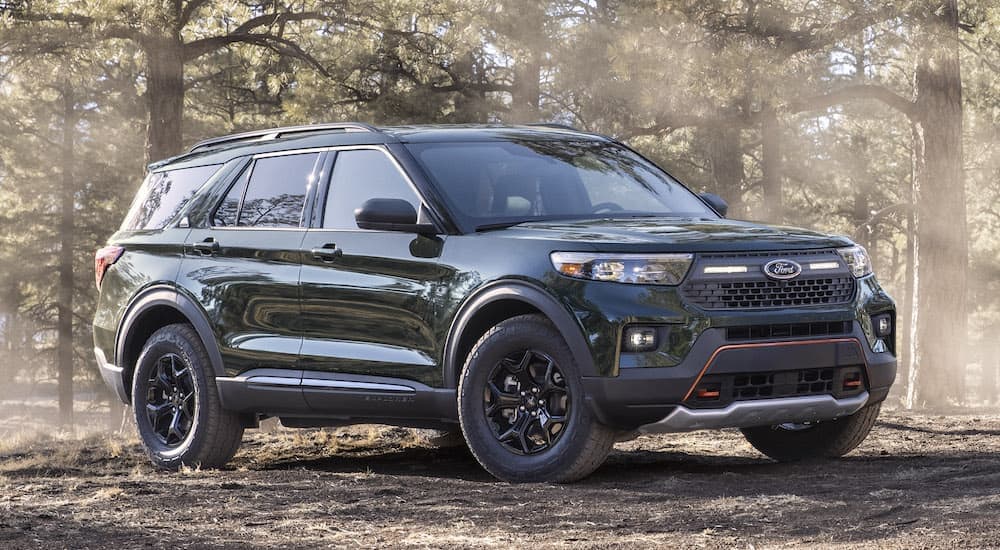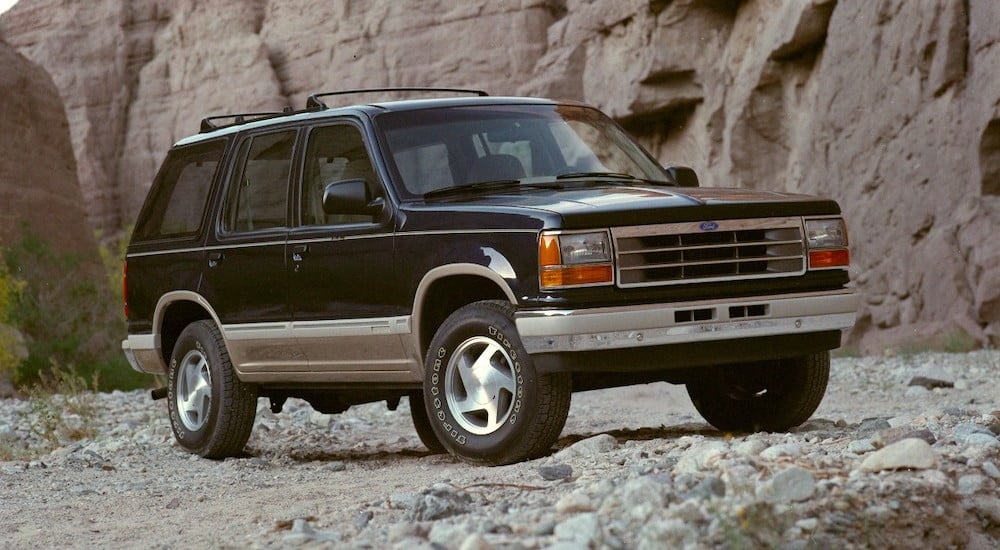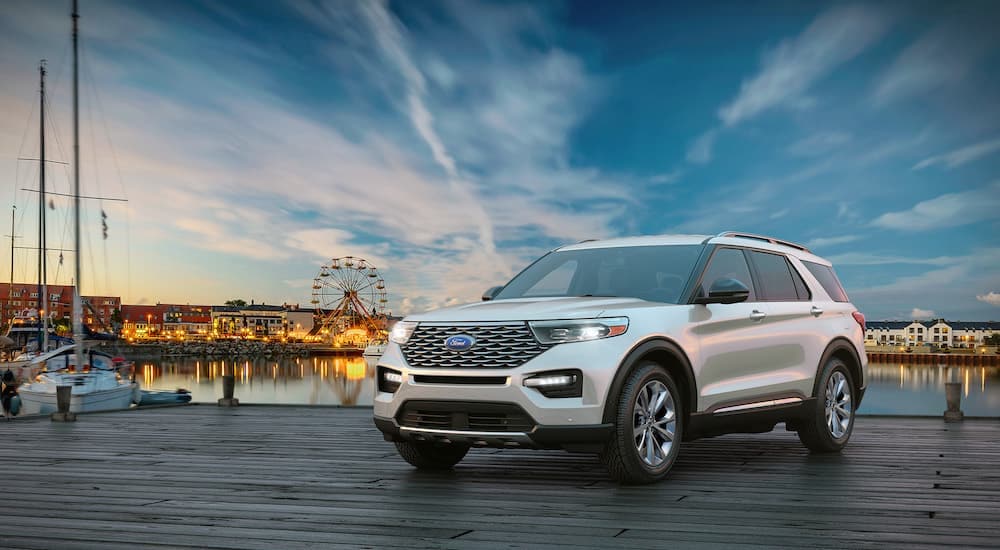
If you've ever been to a used Ford dealership, there's an excellent chance you've crossed paths with a four-door SUV known by many as the Explorer. One of Ford's most popular models and the highest-selling SUV on the market, the Explorer is mainly responsible for the current SUV boom that's been present for the past few decades. While it wasn't until the early 2000s that the SUV gained widespread acclaim and multiple versions from various brands, the Explorer has been building its notoriety for almost a decade. Today, we unravel the history books and look closely at the vehicle that changed the course of the automotive industry and proved just how influential and advantageous the SUV would become.
Humble Beginnings: 1991-2002
The early 1990s were a unique time for Ford and the whole industry. The 1980s had seen an emphasis on vehicles geared towards performance, such as the Mustang, Toyota Supra, and the Chevy Camaro RS. The early 1990s saw Ford develop more commuter-friendly cars, such as the Escort and Taurus, while still producing the Bronco, an SUV meant more for adventurers than the average driver. However, a change was in the air.
The Ford Explorer debuted for the 1991 model year. The guiding principle behind the vehicle was to provide a method of transportation that was ideal for the modeler family but could still travel off the beaten path when the situation called for it. Competing against the Chevy Blazer and Jeep Cherokee, the Explorer had its work cut out from the beginning.
Making an impact on performance from the start, the Explorer was equipped with a 4.0L V6 engine that paired with either a five-speed manual or four-speed automatic transmission. Available in two- and four-door setups, the Explorer was built on the same chassis as the Ford Ranger, making it agile and relatively easy to drive while still capable of performing the daunting tasks that Ford trucks have always been known for.
Following a solid introduction and a few years of excellence, the Ford Explorer entered its second generation in 1995. One of the most significant changes that came with the second generation was the implementation of dual airbags, the first domestically produced SUV to have this feature, which spoke to Ford's dedication to keeping their customers safe.
The Explorer was also gifted with a new exterior design that shifted from the rough-and-tumble designs from the era to a more aesthetically pleasing shape. Around this time, there was a significant upgrade in the vehicle's powertrain. While the Explorer was still powered by a V6, a new small block 5.0L V8 was an optional upgrade. For those interested in performance, 210 hp was now at their disposal, along with optional 4WD.
Sales of the Explorer were rather impressive. From 1995 to 2000, over two million units were sold in the US alone, proof that Ford's idea to make an SUV that was widely accessible to many had already paid off in ways that no one could have possibly foreseen.

The SUV Boom Begins to Take Shape: 2002-2010
As the world shifted into the new millennium, several changes occurred within the automotive industry, just as a decade earlier. For one, the SUV had entered a new stage of popularity, which is still increasing today. The Explorer was no longer the only gig in town, and models such as the Honda CR-V and Toyota RAV-4 were starting to make their mark as viable options for consumers.
As it is always one to adapt to changes, the Ford Explorer underwent significant alterations during this time. The Explorer ceased sharing the same chassis as the Ford Ranger but retained its body-on-frame design. In 2002, the two-door version of the vehicle ceased production, making the Explorer a four-door exclusive SUV. The Explorer also exhibited a new exterior style that had improved upon the design from the previous generation. While the Explorer still offered a V6 and V8 powertrain, 2002 would be the final year in which a manual transmission would be available, and going forward, both engines would pair with a five-speed automatic transmission.
Further changes would be implemented in 2006, as the vehicle entered its fourth generation of production. A newly designed interior and suspension were included, and the Explorer became more refined and sophisticated, with some trims receiving a leather-wrapped steering wheel. Many began to take notice of these improvements, as the Explorer earned a Truck of the Year nomination from Motor Trend Magazine. However, there were even more improvements on the horizon.
Getting Better With Age: 2011- Present Day
2011 was a unique year for the Ford Explorer; the vehicle was entering its fifth generation and celebrated twenty years of being on the road and setting a new standard for what SUV designs should strive for. New changes included a new exterior design that was sophisticated and aerodynamic and was now classified as a crossover model. New powertrains, including a turbocharged four-cylinder, were introduced, demonstrating how far the Explorer had come in the past two decades. While it was recently discontinued, a hybrid version of the Explorer certainly proved that the Explorer could be made more efficient than some of its competitors.
Once again, catering to those who utilized the SUV for their adventures, the Explorer now provided drivers with multiple driving modes that allowed the vehicle to adapt to any terrain that it came across. The new Explorer also quickly gained a reputation for being a safe vehicle, and it was repeatedly awarded a five-star safety rating from the NHTSA in collision testing.
One of the most recent developments of the Explorer has been the introduction of the ST trim. Specifically designed for high performance, with a twin-turbocharged engine, Ford also offers drivers exclusive courses that allow them to learn the intricacies of cornering and acceleration. All trims of the Ford Explorer are now paired with a ten-speed automatic transmission, giving them optimum performance across the board. Recent additions have also included a more extensive infotainment setup to provide access to driving assistance features that have become essential for modern drivers.

The Future Looks Brighter Than Ever
As the Ford Explorer continues to roll off the assembly line each year, new drivers become enchanted and enthusiastic about the SUV that helped launch the vehicle class into the stratosphere of popularity. So, what happens next? There's no denying that the Explorer improves with age, much like a fine wine. With the rumblings of a new design set to debut for the 2025 model year, it's more than safe to assume that the Explorer will continue to gain traction and find new and exciting ways to impress us and surpass any and all expectations we might have regarding its future.
The Ford Explorer is now propelling itself forward for its 30th anniversary. It's astounding to think that an SUV has been in production for this long time, and we're still discussing its attributes and advantages with unbridled enthusiasm. Being a part of this vehicle's lineage is easy. Come on down to Steve Marsh Ford and experience the greatness of the Explorer firsthand…we guarantee that you'll thoroughly enjoy yourself.